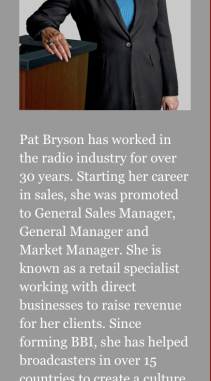
Selling Radio Direct with Pat Bryson
Do you remember the movie, “What Women Want”? Mel Gibson got hit by lightening and began reading women’s minds. That came in quite handy in promoting products to them. Ever wish you could read your clients’ minds? We can come close by studying the internal dialogue clients are having when we approach them at various stages of the sales process. Understanding this will give us the ability to answer their “Why?” This, in turn, will increase our effectiveness.
Our first step is to get the appointment. Our prospect is thinking:
“Do I want to see the salesperson?”
“Do I have the time?”
“What do they want?”
“Radio didn’t work last time.”
“Do I want to spend the money?”
If we can’t give them a good answer to these questions, we don’t even get in the door. And that’s why we use our personal 30 second commercial (see previous newsletters or give me a call and I’ll walk you through it.)
Next the client is deciding if they want to work with you. This usually happens when you are in a client needs analysis.
“Is this salesperson credible?”
“Do they know what they are doing?”
“Can I trust the company?”
“Can they help me?”
How we comport ourselves, the questions we ask, the interest we show in their business contributes to positive or negative answers to these questions.
The dialogue continues in the CNA:
“Do I have the time?”
“Do I trust them enough to share my problems?”
“Will answering these questions help to solve my problems?”
We should talk about the business of the business before we talk about the marketing of the business. This will insure a “Yes” answer to these questions.
We bring back a proposal. What are they thinking now?
“Does this fit my needs?”
“How does this compare to other options?”
“Is this what I want?”
“Is there some commonality here?”
If you have prepared a customized campaign based on the needs and goals you uncovered in the Phase Two needs analysis, the answer should be “Yes”. If you took a package off the shelf, it more than likely will be “No”.
During the presentation the client has other considerations:
“What is the cost?”
“What is the value?”
“Do I want to change what I’m doing now?”
“Do I want to look at other options?”
“Do I believe the reward is greater than the risk?”
Our job is to reduce risk and stack value. One of the best ways to do this is to tell great stories. The best salespeople are the best storytellers.
Now to the decision:
“Do I do it now?”
“Later?”
“Never?”
“Can I justify doing this?”
Have we made our case? Do we have an ROI page to justify the campaign?
And after the sale:
“Did all go as promised?”
“Was I treated fairly?”
“Will it work?”
“How long will it take to see results?”
“Was this a good decision?”
“Will I recommend this to others?”
We should manage our client’s expectations on how and when the campaign will produce results. And, we must take very good care of our clients moving forward. Make an agreement with them on how and when you will contact them. Exceed their expectations.
The last time you made a significant purchase, I bet your internal dialogue was similar to this. The more we can understand and live in our client’s worlds, the better off all will be.
Now, you didn’t even have to get hit by lightening to read minds.
Happy Selling!
